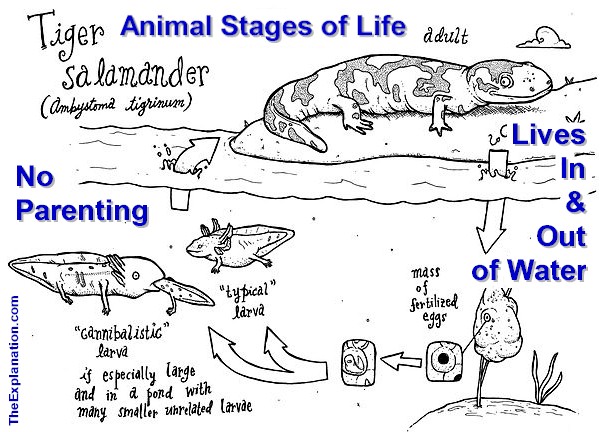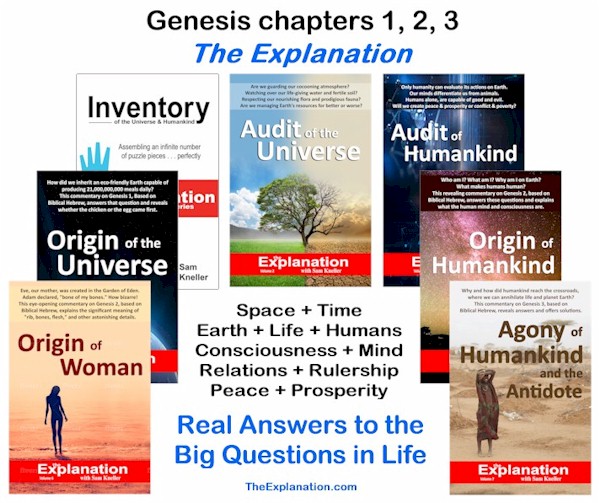Contents
Animal and Human Stages of Life and Sociability reveal that although animals and man live on the same planet, they are worlds apart.

Animal and Human Stages of Life and Sociability reveal that although animals and man live on the same planet, they are worlds apart. The Tiger Salamander breathes and lives in and out of water and is a no-parent species that is autonomous from the instant of its birth.
All animals, with their stages of life, have an uncanny talent to live and survive using their bodily functions and “ways of life.” These ways of life characterize the millions of species. Even within the same family, each animal has its own lifestyle. Female snakes have various ways of reproducing.
(chapter 10.7)
Seventy percent of snakes lay eggs generally in warmer climates, where the heat helps the incubation. However, when natural heat is insufficient, certain females have a mechanical way of heating their bodies. They shiver in order to keep the eggs warm.
This is unusual for cold-blooded reptiles. The rest produce live young. The anaconda actually nourishes its young through a placenta.
This is also unusual for reptiles. Other snakes combine both methods by incubating their eggs internally until they hatch. The babies are then born live. Stages of life vary greatly not only within the animal kingdom but also within particular species.
“Unintelligent” animals have a myriad of differing social habits that help them mate, reproduce, raise their young (though in most cases the young take care of themselves from the word go), and live in a balance of nature with each other, with the flora, and with the inanimate world.
“Unintelligent” #animals have a myriad of differing social habits that help them mate, reproduce, and raise their young. Share on XAs we know, there is violence and confrontation (we watch videos of lions confronting buffalos and hyenas scavenging food). What this means is that animals kill to eat or in self-defense.
They do not perform wanton, wholesale destruction, nor do they kill for fun. Somehow, this vast arena has established a living equilibrium. Can we say the same for man?
Animals do not perform wanton, wholesale #destruction, nor do they kill for fun. Share on X|
Animal Stages and Sociability
|
|
Sex CyclesAnimals mate and produce offspring. Female and male wolves are fertile generally once a year in the winter. There are chronobiological There is no birth control in the animal kingdom per se. A couple of species of killer whales form the exception to this rule. The offspring development period is short. It can last a few weeks to a few months in a very small number of animals. |
Men and women understand reproductive cycles and can use birth control methods such as abstinence, natural family planning, and contraception to control the size of their family. Humans have sexual stages, including puberty, (signaled by the first menses, and first male developments), fertility, and menopause. About one-third of a woman’s life takes place after her childbearing years. The child-raising process is extended for multiple years. |
Sex ActForeplay is instinctive, and there is basically no after play. Animals generally have sex only for reproductive purposes. Examples of sex for “bonding” purposes are few and far between. |
Humans perform and invent a vast variety of sexual behaviors. Man has the capacity to “make love” and take love-making to a higher social level. |
ReproductionAnimals have many hyper-specialized ways to produce offspring. This is only a brief summary of these reproductive methods: • Once in a lifetime Monotremes (a type of mammal) lay eggs. Placentals and marsupials reproduce with a pouch. |
Sexual intercourse, or the insertion of a penis into a vagina, is the only natural way to reproduce. Although there is only one way, the positions a couple may take to perform this act are numerous. Marriage Long-term marriage is the common standard for society, including the establishment of a family and close family relationships. |
OffspringMother dogs and other animals rarely recognize their offspring when they are fully grown. Most animals, including fish, birds, and insects, have no relationship or short contact between generations. |
Parents bond with their children, develop a relationship with them, and recognize them even after spending time apart. This is a deeply accepted part of family culture among humans. |
Next GenerationThe young imitate their progenitors. Crows watch their parents at work. Birds push their young out of the nest and teach them to fly. Some young stay with their parents or parent for weeks or even months before they go their own ways. Generally speaking, they definitively cut ties with their progenitors. Animals never relate to their grandparents. Most young are abandoned to fend for themselves right from birth, or even while the eggs are being laid. |
Children can be more intelligent than their parents, and they can go much further than them both professionally and culturally. They don’t only imitate, they innovate. They have incredible potential that can be developed over their formative years and indeed, their entire lives. They know, recognize, and love their grandparents as well as their aunts, uncles, cousins, and the other members of their extended families. |
Stages of LifeMost animals, insects, and fish are “operational” from the instant they are born. There are exceptions. Birds, bears, and lions care for their young. In these cases, either both parents or the mother (but oftentimes just the mother) takes care of the young. This is most often for a very short period, and often the parents only supply food before the young somehow know how to fend for themselves. Many predators decimate colonies of young. In these cases, only a relative few survive to grow to adulthood. |
As children grow, their senses and capacities develop. We discussed hands in Chapter 8. Dexterity is used to write and in the application of creativity. This and other skills take years to develop. Human children take twenty years to mature. The hand can finally write, make, and do whatever a grown child or adult imagines. They can sculpt, saw, smelt, blow glass, plant corn, weave cloth, cook, create microchips, weld steel, and engage in intellectual pursuits. These ‘growth’ stages of life of children are a key element that I will be expanding. |
Galacti interrogates me quizzically. “Why all these blurbs of information?” What is their relationship to stages of life? he asks. “I can see some readers being upset and disagreeing with such generalizations.”
“I see your point,” I say. “Well, we dealt with some of this in the fauna chapter, and I remind you that we are not dealing with zoology or the social attributes of animals. For more details, I refer you to the references section.
“The broad question is how each of these subjects, or pieces of the puzzle, relates to bringing peace and prosperity to Earth. The fundamental question is this: Do animals have a role to play in this? Can they participate in the discussion via clues and input? Maybe they can contribute through their way of life, but it would only be based on man’s observations and conclusions.
Do #animals have a role to play in bringing peace and prosperity to Earth? Or is this solely a human prerogative? Share on X“Can man answer the question of how to attain peace and prosperity? We’ll see more about that in Audit of the Universe, which is book two of this series. The point is that only man can ask that question. He alone can debate it and eventually lay out steps to attain it.
“There’s a huge, insurmountable gulf between animals and man. As much as we love animals, they can in no way participate in bringing peace and prosperity to Earth. They are as far removed from the process as Betelgeuse, a star situated 640 light-years away from our planet.
“This chapter and the blurbs are here in order to help us comprehend that although animals and man live on the same planet, they are worlds apart.” And the unique cycle of stages of life of humans plays an important role in this differentiation.
Although animals and #humans live on the same planet, they are worlds apart. Share on XThis post is an excerpt from chapter 10.7 of Inventory of the Universe.
The Explanation Blog Bonus
This video is more about development to birth. But it is instructive and revealing in discussing Lamarck’s scientific or rather unscientific contribution, his way of analyzing such development, which has erroneously become part of the biological thinking process.
In this next video from Illustra Media’s documentary FLIGHT: THE GENIUS OF BIRDS we’ll enter a fertilized egg to follow a bird’s embryonic development. Spectacular animation and live action footage document the extraordinary 21-day process of organization and growth from a few cells into a chicken. Again, more ‘development’ but spectacular.
This one is about animal life cycles … I promise. Various types of animals and their stages of life including their metamorphosis from one stage to a totally different one. Think about this in comparison to human stages of life.
Dig Deeper into The Explanation
Online Study Courses to Uncover the Mystery of Adam and Eve’s Nakedness… with no fuss. Free video mini-course revealing the God-intended meaning of Scripture via Biblical Hebrew. It’s so easy, it’ll blow you away. Join now and add new motivation to your Bible study.
Join The Explanation Newsletter to stay informed of updates. and future events. No obligations, total privacy, unsubscribe anytime, if you want.
The Explanation series of seven books. Free to read online or purchase these valuable commentaries on Genesis 1-3 from your favorite book outlet. E-book and paperback formats are available. Use this link to see the details of each book and buy from your favorite store.

Since you read all the way to here… you liked it. Please use the Social Network links just below to share this information from The Explanation, Animal and Human Stages of Life and Sociability. What do They Tell Us?



Trackbacks/Pingbacks